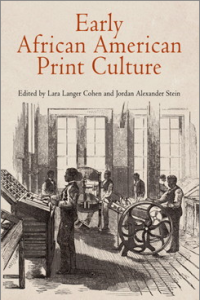 “Bottles of Ink and Reams of Paper: Clotel, Racialization, and the Material Culture of Print” Early African American Print Culture eds. Lara Langer Cohen and Jordan Alexander Stein, Philadelphia: University of Pennsylvania Press, 2012. [LINK] [LINK]
“Bottles of Ink and Reams of Paper: Clotel, Racialization, and the Material Culture of Print” Early African American Print Culture eds. Lara Langer Cohen and Jordan Alexander Stein, Philadelphia: University of Pennsylvania Press, 2012. [LINK] [LINK]
“This essay argues that greater attention to the significance of the material culture of print, especially in early African American print culture, shows how technologies of racialization emerge in conjunction with technologies of printed words and images. The stereotype is perhaps the most familiar case. In one sense it o ff ers quick reproduction of legible text, and in another it offers quick reproduction of a legible social type. In the rest of this essay, I examine how another technology of legibility, black/white dualism, structures both print legibility and racial legibility. This essay proposes that the material culture of whiteness in antebellum print culture participates in nineteenth-century racial formation by modeling how whiteness is to be seen while unseen, providing the structural backdrop against which marks or types become legible. I will focus on the materiality of paper (and to a lesser extent, ink) because, as Brown himself suggests in the opening sentences of the 1867 edition of Clotel, these materials transmit the author’s writing about racial categorizations of blackness and whiteness while they also shape the sensus communis about whiteness, blackness, and structures of legibility and visibility. Reading print relies on making meaning out of the di ff erence between black and white, and in the antebellum period where black ink and white paper were racially coded, the black/white dualism underwriting print legibility further naturalized black/white racial dualism by implying the possibility of “reading” bodies in relation to one another.”
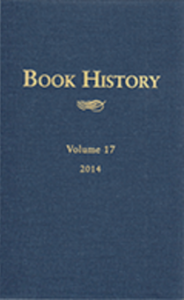 “Paper Nationalism: Material Textuality and Communal Affiliation in Early America” Book History Vol 19 (2016).
“Paper Nationalism: Material Textuality and Communal Affiliation in Early America” Book History Vol 19 (2016).
“Theories of the public sphere and of imagined political communities of shared reading have had lasting effects on the theoretical conceptualization of Americanist book history, but they also largely overlook the materiality of texts in ways that early and nineteenth-century American readers and writers did not. This essay reads early and nineteenth-century American texts about paper that show how affiliation and political community could inhere within material texts. Further, it argues that an orientation toward textual materiality can help us reveal publics that are more inclusive of women, nonwhites, and nonelites.”
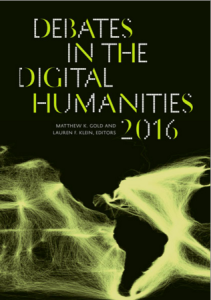 “Between Knowledge and Metaknowledge: Shifting Disciplinary Borders in Digital Humanities and Library and Information Studies” Debates in the Digital Humanities 2016, eds. Matthew K. Gold and Lauren F. Kline, University of Minnesota Press, 2016. [LINK] [LINK]
“Between Knowledge and Metaknowledge: Shifting Disciplinary Borders in Digital Humanities and Library and Information Studies” Debates in the Digital Humanities 2016, eds. Matthew K. Gold and Lauren F. Kline, University of Minnesota Press, 2016. [LINK] [LINK]
“The emergence of the digital humanities in specialized disciplines and librarianship alike necessitates a recalibration of this allocation of knowledge and practice. DH in the disciplines has brought discussion of metaknowledge—data structures, archival and editorial standards, digital curation and representation—into the graduate education of disciplinary specialists. But what about in LIS graduate education, where metaknowledge training has long been the standard model? To train digital humanities librarians, unique from digital librarians or generalist academic librarians, LIS programs and students need to spend more than a figurative six hours on a humanities subject compared to 147 hours organizing and representing information about it. I take Dickinson’s temporal division of knowledge labor as symbolic of divisions that have been fairly consistent in LIS education and practice from Dickinson’s time until ours.”
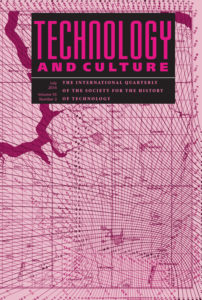 “Rags Make Paper, Paper Makes Money: Material Texts and the Creation of Capital”
“Rags Make Paper, Paper Makes Money: Material Texts and the Creation of Capital”
Technology and Culture (forthcoming)
“In the antebellum United States, images of paper and rags were recruited in service of widely divergent representations of the economy; paper raised fundamental questions about the nature of value and exchange. Paper was a technology of capitalism. I mean this in two ways. First, paper is a technology of capitalism in the broader context [in which] blanks, forms, and account books gave rise to habits of economic activity and thought. Second, I also mean that paper became a metaphor for the representation of particular forms of capitalist exchange and wealth extraction, and it is in this area that my contribution to the forum dwells. “Rags to riches” narratives and references to printed words or visual texts “not worth the paper they are printed on” refer to the specific technologies of paper making, but they are also expressions that structure thought and feeling about how wealth is created and in what material or process it inheres. The technology of paper making itself was frequently essential to figurations of the economy. The process of turning to rags to paper could represent both a lucrative industry and a convenient way to lament the turn to rag paper over specie.”
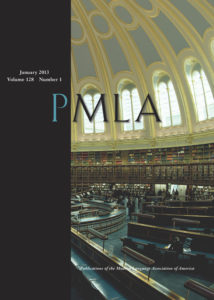 “George Moses Horton, ‘Individual Influence’” transcription and critical introduction. PMLA
“George Moses Horton, ‘Individual Influence’” transcription and critical introduction. PMLA
(forthcoming)
Transcription of and introduction to newly discovered George Morton Horton manuscript, “Individual Influence.””Individual Influence” is an essay in Horton’s hand, collected in the papers of Henry Harrisse with documents related to the 1856 Chapel Hill “Black Republican” abolition controversy, about the balance of influence between the “terrestrial” and “celestial,” the worldly and the spiritual influences.